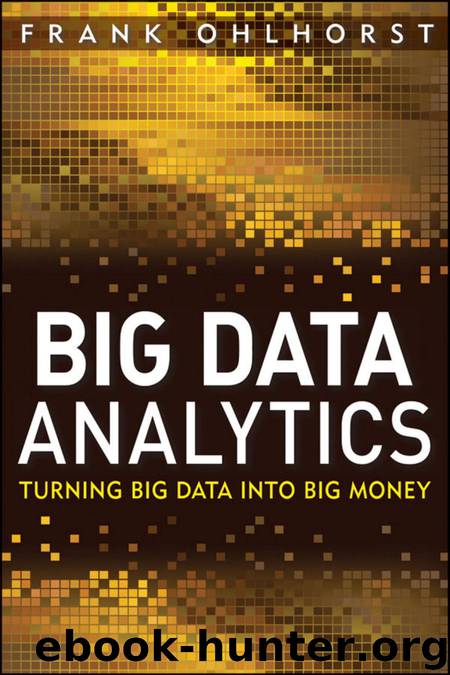Big Data Analytics by Ohlhorst Frank

Author:Ohlhorst, Frank [Ohlhorst, Frank]
Language: eng
Format: epub
Published: 2012-10-26T04:48:50+00:00
S E C U R I T Y , C O M P L I A N C E , A U D I T I N G , A N D P R O T E C T I O N ¥
65
There is no easy answer to that dilemma, and it becomes a case of
choosing the lesser of two evils. If the data have intrinsic value for
analytics, they must be kept, but that does not mean they need to be
kept on a system that is connected to the Internet or other systems.
The data can be archived, retrieved for processing, and then returned
to the archive.
CLASSIFYING DATA
Protecting data becomes much easier if the data are classified—that is,
the data should be divided into appropriate groupings for management
purposes. A classification system does not have to be very sophisticated
or complicated to enable the security process, and it can be limited to
a few different groups or categories to keep things simple for proces-
sing and monitoring.
With data classification in mind, it is essential to realize that all data are not created equal. For example, Internal e-mails between two
colleagues should not be secured or treated the same way as financial
reports, human resources (HR)information, or customer data.
Understanding the classifications and the value of the data sets is
not a one-task job; the life-cycle management of data may need to be
shared by several departments or teams in an enterprise. For example,
you may want to divide the responsibilities among technical, security,
and business organizations. Although it may sound complex, it really
isn’t all that hard to educate the various corporate shareholders to
understand the value of data and where their responsibilities lie.
Classification can become a powerful tool for determining the sen-
sitivity of data. A simple approach may just include classifications such as financial, HR, sales, inventory, and communications, each of which is
self-explanatory and offers insight into the sensitivity of the data.
Once organizations better understand their data, they can take
important steps to segregate the information, which will make the
deployment of security measures like encryption and monitoring more
manageable. The more data are placed into silos at higher levels, the easier it becomes to protect and control them. Smaller sample sizes are easier to protect and can be monitored separately for specific necessary controls.
c07
22 October 2012; 17:58:55
Download
This site does not store any files on its server. We only index and link to content provided by other sites. Please contact the content providers to delete copyright contents if any and email us, we'll remove relevant links or contents immediately.
Sass and Compass in Action by Wynn Netherland Nathan Weizenbaum Chris Eppstein Brandon Mathis(7968)
Supercharging Productivity with Trello by Brittany Joiner(7325)
Mastering Tableau 2023 - Fourth Edition by Marleen Meier(7095)
Inkscape by Example by István Szép(6967)
Secrets of the JavaScript Ninja by John Resig Bear Bibeault(6737)
Visualize Complex Processes with Microsoft Visio by David J Parker & Šenaj Lelić(6647)
Build Stunning Real-time VFX with Unreal Engine 5 by Hrishikesh Andurlekar(5675)
Design Made Easy with Inkscape by Christopher Rogers(4996)
Customizing Microsoft Teams by Gopi Kondameda(4539)
Business Intelligence Career Master Plan by Eduardo Chavez & Danny Moncada(4437)
Extending Microsoft Power Apps with Power Apps Component Framework by Danish Naglekar(4151)
Salesforce Platform Enterprise Architecture - Fourth Edition by Andrew Fawcett(4012)
Linux Device Driver Development Cookbook by Rodolfo Giometti(4008)
Pandas Cookbook by Theodore Petrou(4005)
The Tableau Workshop by Sumit Gupta Sylvester Pinto Shweta Sankhe-Savale JC Gillet and Kenneth Michael Cherven(3817)
Exploring Microsoft Excel's Hidden Treasures by David Ringstrom(3290)
TCP IP by Todd Lammle(3118)
Applied Predictive Modeling by Max Kuhn & Kjell Johnson(3006)
Drawing Shortcuts: Developing Quick Drawing Skills Using Today's Technology by Leggitt Jim(2975)
